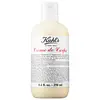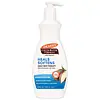What's inside
What's inside
 Key Ingredients
Key Ingredients

 Benefits
Benefits

 Concerns
Concerns

 Ingredients Side-by-side
Ingredients Side-by-side

Water
Skin ConditioningHydrogenated Polyisobutene
EmollientGlycerin
HumectantCoco-Caprylate/Caprate
EmollientPropylene Glycol
HumectantPEG-100 Stearate
Glyceryl Stearate
EmollientSqualane
EmollientStearyl Alcohol
EmollientHelianthus Annuus Seed Oil
EmollientButyrospermum Parkii Butter
Skin ConditioningMyristyl Alcohol
EmollientPPG-5 Pentaerythrityl Ether
EmollientPEG-5 Pentaerythrityl Ether
EmollientOlea Europaea Fruit Oil
MaskingSesamum Indicum Seed Oil
EmollientDimethicone
EmollientPhenoxyethanol
PreservativeIsopropyl Palmitate
EmollientCitric Acid
BufferingCera Microcristallina
Emulsion StabilisingPentaerythrityl Tetra-Di-T-Butyl Hydroxyhydrocinnamate
AntioxidantChlorphenesin
AntimicrobialPotassium Sorbate
PreservativeGlycine Soja Sterols
EmollientArgilla
AbrasiveXanthan Gum
EmulsifyingSodium PCA
HumectantAllantoin
Skin ConditioningPrunus Amygdalus Dulcis Oil
Skin ConditioningPrunus Armeniaca Kernel Oil
MaskingTheobroma Cacao Seed Butter
EmollientPersea Gratissima Oil
Skin ConditioningTocopherol
AntioxidantGlycine Soja Oil
EmollientLecithin
EmollientAloe Barbadensis Leaf Juice Powder
Skin ConditioningCI 40800
Cosmetic ColorantWater, Hydrogenated Polyisobutene, Glycerin, Coco-Caprylate/Caprate, Propylene Glycol, PEG-100 Stearate, Glyceryl Stearate, Squalane, Stearyl Alcohol, Helianthus Annuus Seed Oil, Butyrospermum Parkii Butter, Myristyl Alcohol, PPG-5 Pentaerythrityl Ether, PEG-5 Pentaerythrityl Ether, Olea Europaea Fruit Oil, Sesamum Indicum Seed Oil, Dimethicone, Phenoxyethanol, Isopropyl Palmitate, Citric Acid, Cera Microcristallina, Pentaerythrityl Tetra-Di-T-Butyl Hydroxyhydrocinnamate, Chlorphenesin, Potassium Sorbate, Glycine Soja Sterols, Argilla, Xanthan Gum, Sodium PCA, Allantoin, Prunus Amygdalus Dulcis Oil, Prunus Armeniaca Kernel Oil, Theobroma Cacao Seed Butter, Persea Gratissima Oil, Tocopherol, Glycine Soja Oil, Lecithin, Aloe Barbadensis Leaf Juice Powder, CI 40800
Water
Skin ConditioningTheobroma Cacao Extract
Skin ConditioningGlyceryl Stearate
EmollientPetrolatum
EmollientPropylene Glycol
HumectantGlycerin
HumectantCocos Nucifera Oil
MaskingParaffinum Liquidum
EmollientTheobroma Cacao Seed Butter
EmollientElaeis Guineensis Oil
EmollientCetyl Alcohol
EmollientDimethicone
EmollientTocopherol
AntioxidantHelianthus Annuus Seed Oil
EmollientHydroxyethylcellulose
Emulsion StabilisingPEG-8 Stearate
EmulsifyingBehentrimonium Methosulfate
Butylene Glycol
HumectantStearalkonium Chloride
PreservativeCellulose
AbsorbentSodium Acetate
BufferingParfum
MaskingDimethyl Stearamine
EmulsifyingPhenoxyethanol
PreservativeSorbic Acid
PreservativeBenzoic Acid
MaskingStearyl Alcohol
EmollientMyristyl Alcohol
EmollientCI 19140
Cosmetic ColorantCI 15510
Cosmetic ColorantBenzyl Alcohol
PerfumingWater, Theobroma Cacao Extract, Glyceryl Stearate, Petrolatum, Propylene Glycol, Glycerin, Cocos Nucifera Oil, Paraffinum Liquidum, Theobroma Cacao Seed Butter, Elaeis Guineensis Oil, Cetyl Alcohol, Dimethicone, Tocopherol, Helianthus Annuus Seed Oil, Hydroxyethylcellulose, PEG-8 Stearate, Behentrimonium Methosulfate, Butylene Glycol, Stearalkonium Chloride, Cellulose, Sodium Acetate, Parfum, Dimethyl Stearamine, Phenoxyethanol, Sorbic Acid, Benzoic Acid, Stearyl Alcohol, Myristyl Alcohol, CI 19140, CI 15510, Benzyl Alcohol
 Reviews
Reviews

Ingredients Explained
These ingredients are found in both products.
Ingredients higher up in an ingredient list are typically present in a larger amount.
Dimethicone is a type of synthetic silicone created from natural materials such as quartz.
What it does:
Dimethicone comes in different viscosities:
Depending on the viscosity, dimethicone has different properties.
Ingredients lists don't always show which type is used, so we recommend reaching out to the brand if you have questions about the viscosity.
This ingredient is unlikely to cause irritation because it does not get absorbed into skin. However, people with silicone allergies should be careful about using this ingredient.
Note: Dimethicone may contribute to pilling. This is because it is not oil or water soluble, so pilling may occur when layered with products. When mixed with heavy oils in a formula, the outcome is also quite greasy.
Learn more about DimethiconeGlycerin is already naturally found in your skin. It helps moisturize and protect your skin.
A study from 2016 found glycerin to be more effective as a humectant than AHAs and hyaluronic acid.
As a humectant, it helps the skin stay hydrated by pulling moisture to your skin. The low molecular weight of glycerin allows it to pull moisture into the deeper layers of your skin.
Hydrated skin improves your skin barrier; Your skin barrier helps protect against irritants and bacteria.
Glycerin has also been found to have antimicrobial and antiviral properties. Due to these properties, glycerin is often used in wound and burn treatments.
In cosmetics, glycerin is usually derived from plants such as soybean or palm. However, it can also be sourced from animals, such as tallow or animal fat.
This ingredient is organic, colorless, odorless, and non-toxic.
Glycerin is the name for this ingredient in American English. British English uses Glycerol/Glycerine.
Learn more about GlycerinGlyceryl Stearate is a mix of glycerin and stearic acid.
It is used to stabilize the mixing of water and oil ingredients. By preventing these ingredients from separating, it can help elongate shelf life. It can also help thicken the product's texture.
As an emollient, it helps soften skin and supports barrier-replenishing ingredients.
In cosmetics, Glyceryl Stearate is often made from vegetable oils or synthetically produced.
This ingredient may not be fungal-acne safe
Fun fact: The human body also creates Glyceryl Stearate naturally.
Learn more about Glyceryl StearateHelianthus Annuus Seed Oil is the oil derived from the seeds of a Sunflower. Sunflower seed oil is non-fragrant. It is an emollient, meaning it helps to soften the skin.
Sunflower seed oil contains many fatty acids. The fatty acids found in sunflower seeds include (from highest amount to least): linoleic acid, myristic acid, palmitic acid, stearic acid, arachidic acid, oleic acid, and linolenic acid.
These fatty acids help the skin create ceramides. Ceramides play a role in repairing the skin barrier.
Helianthus Annuus Seed Oil helps moisturize the skin. This in turn helps the skin look more rejuvenated and smoother.
Sunflowers are rich in vitamin E.
Historians believe Indigenous cultures of North America domesticated sunflowers before corn. Thus they relied on sunflower oil for a variety of uses. One such use is moisturizing skin and hair.
Sunflower seed oil may not be fungal acne safe. We recommend speaking with a professional if you have any concerns.
Learn more about Helianthus Annuus Seed OilMyristyl Alcohol is type of fatty alcohol. It is a white, waxy solid and insoluble in water.
As an emollient, it hydrates the skin by trapping moisture in.
Fatty Alcohols are most often used as an emollient or to thicken a product. They are usually derived from natural fats and oils and therefore do not have the same drying or irritating effect as solvent alcohols.
Learn more about Myristyl AlcoholPhenoxyethanol is a preservative that has germicide, antimicrobial, and aromatic properties. Studies show that phenoxyethanol can prevent microbial growth. By itself, it has a scent that is similar to that of a rose.
It's often used in formulations along with Caprylyl Glycol to preserve the shelf life of products.
Propylene Glycol is an odorless, colorless liquid. As a humectant, it helps skin retain moisture. It also aids in delivering active ingredients.
Another role of this ingredient is preventing a product from melting or freezing. Propylene glycol also adds antimicrobrial properties to a product, elongating product lifespan.
This ingredient is considered an organic alcohol and commonly added into both cosmetics and foods.
Those with sensitive skin or conditions may develop a rash when using this ingredient.
Learn more about Propylene GlycolStearyl Alcohol is a type of fatty alcohol from stearic acid. It is a white, waxy compound used to emulsify ingredients.
Fatty Alcohols are most often used as an emollient or to thicken a product. Emollients help soothe and hydrate the skin by trapping moisture.
They are usually derived from natural fats and oils and therefore do not have the same drying or irritating effect as solvent alcohols. FDA allows products labeled "alcohol-free" to have fatty alcohols.
Learn more about Stearyl AlcoholTheobroma Cacao Seed Butter comes from the Theobroma cacoa, or Cacao tree. Cacao trees are native to tropical landscapes.
Like other plant butters, Cacao seed butter is an emollient. Emollients help soothe and soften your skin. By creating a barrier to trap moisture in, emollients help keep your skin hydrated.
Cacao seed butter contains antioxidants known as polyphenols. Antioxidants help fight free-radical molecules by stabilizing them. Unstable free-radicals may cause damage to your skin cells. Antioxidants may help with anti-aging.
Theobroma Cacao Seed Butter can be bad for acne prone skin.
Learn more about Theobroma Cacao Seed ButterTocopherol (also known as Vitamin E) is a common antioxidant used to help protect the skin from free-radicals and strengthen the skin barrier. It's also fat soluble - this means our skin is great at absorbing it.
Vitamin E also helps keep your natural skin lipids healthy. Your lipid skin barrier naturally consists of lipids, ceramides, and fatty acids. Vitamin E offers extra protection for your skin’s lipid barrier, keeping your skin healthy and nourished.
Another benefit is a bit of UV protection. Vitamin E helps reduce the damage caused by UVB rays. (It should not replace your sunscreen). Combining it with Vitamin C can decrease sunburned cells and hyperpigmentation after UV exposure.
You might have noticed Vitamin E + C often paired together. This is because it is great at stabilizing Vitamin C. Using the two together helps increase the effectiveness of both ingredients.
There are often claims that Vitamin E can reduce/prevent scarring, but these claims haven't been confirmed by scientific research.
Learn more about TocopherolWater. It's the most common cosmetic ingredient of all. You'll usually see it at the top of ingredient lists, meaning that it makes up the largest part of the product.
So why is it so popular? Water most often acts as a solvent - this means that it helps dissolve other ingredients into the formulation.
You'll also recognize water as that liquid we all need to stay alive. If you see this, drink a glass of water. Stay hydrated!
Learn more about Water